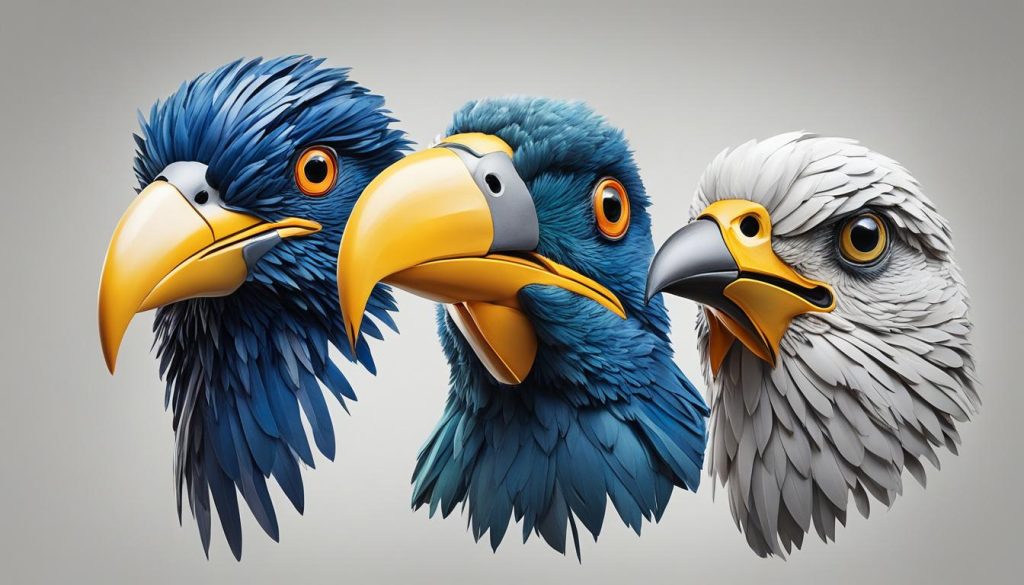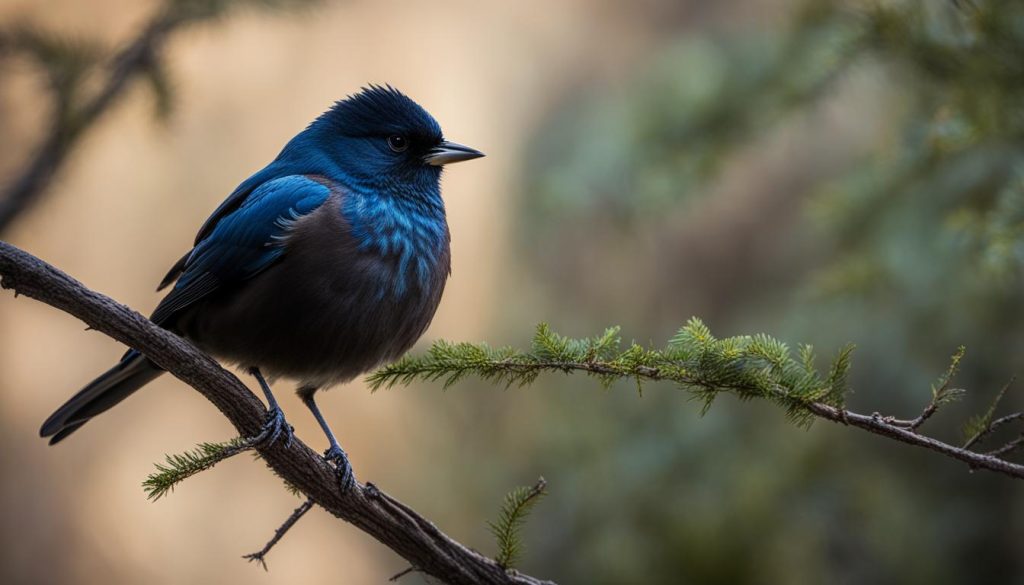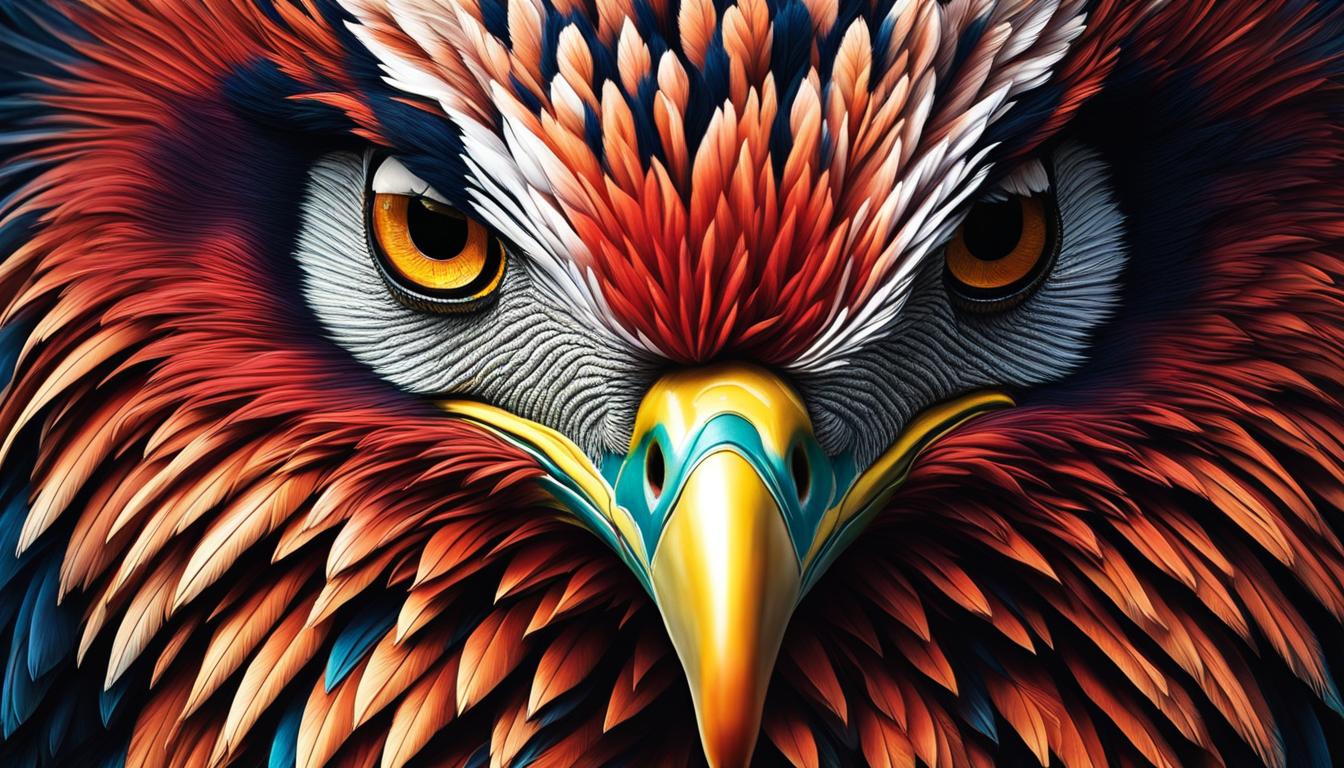Bird portraiture is an exquisite form of avian photography, where the goal is to capture the character and essence of birds through vivid and lifelike images. By paying attention to the angle of the bird’s head, composition, and post-processing techniques, photographers can create stunning portraits that bring out the true nature of these magnificent creatures.
When it comes to bird portraiture, it’s all about capturing the personality and spirit of the bird. Every bird has its own unique character, and the challenge for photographers is to portray it accurately in a single image. This requires careful consideration of various factors, such as the angle of the bird’s head and the overall composition of the photograph.
By experimenting with different angles, photographers can convey different emotions and expressions. A straight head-on perspective, for example, can create a sense of intensity and focus, while a side view may showcase elegance and grace. The position of the head plays a vital role in capturing expression and detail, adding depth to the image.
Attention to detail is crucial in bird portraiture. Photographers must focus on the small intricacies that make each species unique, such as the details of the nostrils or the bird’s lores. These subtle elements can greatly enhance the overall composition and highlight the distinct features of the bird.
In addition to the bird itself, the background and lighting are important considerations in bird portraiture. A clean and unobstructed background ensures that the bird remains the main focal point of the image. Catching the light in the bird’s eye adds life to the portrait, but it’s essential to strike a balance and avoid obscuring the pupil. Artificial lighting should be used sparingly to maintain a natural look.
Post-processing techniques can take bird portraits to the next level. Adjusting the lighting, enhancing details, and removing distractions can greatly improve the overall quality of the image. However, it’s essential to retain the natural character of the bird and avoid over-processing.
Choosing the right equipment, such as a camera with a telephoto lens, is essential for capturing the intricate details of birds. The choice of focal length and aperture helps ensure that both the bird’s eyes and beak are in focus. Additionally, using a fast shutter speed is crucial to freeze the movement of the bird’s head and capture the perfect moment.
Bird portraiture is a captivating genre of avian photography that allows photographers to showcase the beauty, personality, and character of our feathered friends. With careful attention to details, composition, lighting, and post-processing techniques, photographers can create stunning bird portraits that truly capture the essence of these magnificent creatures.
Key Takeaways:
- Bird portraiture focuses on capturing the character and essence of birds through vivid and lifelike images.
- The angle of the bird’s head and overall composition are essential considerations in bird portraiture.
- Capturing expression and detail adds depth and character to bird portraits.
- The background and lighting play crucial roles in creating impactful bird portraits.
- Post-processing techniques can enhance the overall quality of bird portraits, but it’s important to retain the natural character of the bird.
Considerations in Bird Portraiture
When it comes to bird portraiture, several key considerations can significantly enhance the visual impact of your photographs. Understanding the angle of the bird’s head, mastering composition techniques, and utilizing post-processing techniques are all crucial elements in capturing captivating bird portraits.
Selecting the Right Angle
The angle of the bird’s head plays a vital role in conveying the desired emotions and creating a strong visual impact. While a front-angle view might appear weak, a straight head-on perspective brings intensity and focus to the image. This angle not only captures the bird’s character but also allows viewers to connect emotionally with the subject.
Creating a Compelling Composition
The composition of the image is another critical aspect of bird portraiture. Positioning the bird against an unobstructed background helps to draw attention to the subject and eliminate distractions. Additionally, incorporating an open beak into the composition adds intrigue and emphasizes the bird’s natural behaviors.
Creating a focal point by utilizing the rule of thirds or leading lines can further enhance the composition and guide the viewer’s gaze. By paying careful attention to the placement of elements within the frame, you can create visually balanced and engaging compositions.
Leveraging Post-Processing Techniques
Post-processing techniques offer endless possibilities for refining and enhancing bird portraits. Adjusting the lighting and colors can help accentuate the bird’s features and create a more visually appealing image. Additionally, removing distractions or imperfections and emphasizing details in post-processing can elevate the overall quality of the portrait.
Experiment with different post-processing techniques to discover your own unique style and bring out the character and beauty of the birds you photograph.
Remember, the ultimate goal of bird portraiture is to capture the essence and personality of these fascinating creatures. By considering the angle of the bird’s head, mastering composition techniques, and leveraging post-processing, you can create stunning bird portraits that truly captivate the viewer.
| Considerations | Benefits |
|---|---|
| Angle of the bird’s head | Creates intensity and focus in the image |
| Composition | Eliminates distractions and adds interest |
| Post-processing techniques | Enhances lighting and emphasizes details |
Capturing Expression and Detail
Birds have an incredible ability to convey emotions and express themselves through the position of their heads. Capturing these expressive bird heads in photographs not only adds depth but also brings character to the image. It allows viewers to connect with the subject on a more intimate level.
When photographing birds, attention to detail is essential. By paying close attention to the smaller elements, such as the intricate details of the nostrils and the bird’s lores (the space between the eye and beak), photographers can highlight the unique features of each bird species. This level of detail helps to create truly captivating images that showcase the beauty and variety of avian life.
In post-processing, it’s vital to focus on the small details that can enhance the overall quality of the portrait. Removing distractions, such as dust particles or background clutter, allows the viewer’s attention to remain solely on the bird. By honing in on the key features and capturing the tiniest of details, photographers can create visually pleasing portraits that truly represent the essence of the subject.

Throughout the process, the intent is to capture not just the physical appearance of the bird, but also the intangible qualities that make each species unique. It’s a skill that requires both technical understanding and an artistic eye. The position of the head, the expression in the eyes, and the overall composition of the image all play a significant role in conveying the personality and character of the bird.
Example of Bird Portraiture Detail
“In capturing a portrait of a majestic bald eagle, I focused on the intricacies of its head. The piercing eyes, the textured feathers, and the regal posture all added to the overall sense of power and grace. By zooming in and capturing these intimate details, I was able to create an image that showcases the unique qualities of this iconic bird.”
When photographing birds, it’s important to remember that they are living creatures with their own personalities and quirks. Taking the time to observe their behavior and anticipate their movements can greatly enhance the chances of capturing an expressive and detailed portrait.
| Tips for Capturing Expression and Detail |
|---|
| 1. Experiment with different angles to find the most flattering position of the bird’s head. |
| 2. Pay attention to the eyes and beak, ensuring they are in sharp focus and accurately represent the bird’s expression. |
| 3. Look for unique features and details that make the bird stand out, such as colorful feathers or unique markings. |
| 4. Remove distractions in the background or foreground that may divert attention away from the bird. |
| 5. Use post-processing techniques to enhance details, such as increasing sharpness or adjusting lighting. |
Background and Lighting Considerations
The background and lighting are essential elements in bird portraiture, as they greatly impact the overall aesthetic and quality of the photograph.
When selecting a background, it’s important to choose an unobstructed one that doesn’t distract from the main subject—the bird. An unobstructed background allows the bird to take center stage and ensures that the viewer’s attention remains focused on the bird’s beauty and unique features.
In addition to the background, lighting plays a crucial role in capturing stunning bird portraits. One key technique to consider is the use of catch light—the reflection of light in the bird’s eye. Catch light adds life and a spark of animation to the image, giving the bird’s eyes a captivating glimmer. However, it’s crucial to strike a balance and ensure that the catch light doesn’t obscure the pupil, as it may make the bird appear unnatural.
When photographing birds in man-made environments, such as zoos or aviaries, photographers must be cautious with artificial lighting. Artificial light can create an artificial look or reflect man-made structures in the bird’s eye, compromising the authenticity of the portrait. It’s essential to be mindful of these considerations and adjust the angle of the bird’s head to minimize unwanted reflections or artificial lighting effects.

Table: Background and Lighting Considerations
| Considerations | Tips |
|---|---|
| Background Selection | Choose an unobstructed background to keep the focus on the bird. Avoid backgrounds that are cluttered or visually distracting. |
| Catch Light | Utilize catch light to add life and sparkle to the bird’s eyes. Ensure that the catch light doesn’t obscure the pupil. |
| Artificial Lighting | Be mindful of artificial lighting in man-made environments as it can create an unnatural look or reflect man-made structures in the bird’s eye. |
Post-Processing and Attention to Detail
Post-processing techniques are essential in bringing out the true potential of bird portraits. By carefully adjusting various elements, photographers can enhance details, remove distractions, and create stunning images that capture the essence of the bird. Let’s explore some essential post-processing techniques that can take your bird portraiture to the next level.
Adjusting the Dynamic Range
One important aspect of post-processing is adjusting the dynamic range of the image. This involves optimizing the balance between the highlights and shadows to ensure that all details are visible. By carefully adjusting the exposure, contrast, and shadows, you can bring out the intricate textures and patterns of the bird’s feathers, resulting in a more captivating portrait.
Adding Fill Light
Another effective technique is adding fill light to enhance the overall brightness and clarity of the image. Fill light helps to illuminate any areas that may appear dark or underexposed, revealing hidden details and adding depth to the portrait. Use this technique sparingly to avoid overexposing the image and maintaining a natural look.
Improving Contrast
Enhancing the contrast of an image can significantly impact its visual impact. By carefully adjusting the contrast settings, you can make the bird stand out from its background and create a more visually appealing portrait. However, it’s crucial to strike a balance and avoid overdoing it, as excessive contrast adjustments can make the image look unrealistic.
Post-processing techniques, such as adjusting the dynamic range, adding fill light, and improving contrast can help photographers enhance the details and overall quality of bird portraits, captivate viewers, and create visually stunning images.
Removing Distractions
In post-processing, removing distractions is essential to ensure that the focus remains on the bird. This involves eliminating any elements that may divert the viewer’s attention from the main subject. Common distractions can include dust spots, debris, or background elements that are visually intrusive. By carefully retouching the image and removing these distractions, you can create a cleaner and more visually pleasing bird portrait.
Here is an example of how post-processing techniques can help remove distractions and enhance details in a bird portrait:
Retaining the Natural Character
While post-processing allows for creative adjustments, it’s crucial to retain the natural character of the bird. Portraits that appear overly manipulated can lose their authenticity and fail to capture the true essence of the subject. Avoid excessive retouching and maintain the integrity of the bird’s features to create a portrait that feels genuine and authentic.
By employing these post-processing techniques and paying attention to small details, you can elevate your bird portraits to new heights, creating images that are visually captivating, and reflect the true personality of these remarkable creatures.
Equipment and Techniques
Choosing the right camera gear is essential for capturing stunning bird portraits. A telephoto lens allows photographers to get in close and capture intricate details of the birds. When it comes to focal length, opt for a longer lens to bring the bird closer and create a more intimate composition.
Aperture plays a crucial role in bird portraiture, especially when it comes to focusing on the bird’s eyes and beak. Selecting a wider aperture (smaller f-number) can create a shallow depth of field, blurring the background and drawing attention to the subject. This technique adds a sense of depth and enhances the overall aesthetic of the portrait.
Another important consideration is shutter speed. Birds are highly active creatures, making it essential to freeze their fast movements. Use a fast shutter speed to capture the bird’s head sharply, ensuring that every detail is perfectly preserved in your image.
Experimenting with different techniques and equipment can lead to unique and captivating bird portraits. Get creative and try new approaches to stand out and produce exceptional results. Now, let’s take a look at a table showcasing some popular camera gear options for bird portraiture:
| Camera | Lens | Focal Length | Shutter Speed |
|---|---|---|---|
| Nikon D850 | Nikon AF-S 500mm f/5.6E PF ED VR | 500mm | 1/2000 sec |
| Canon EOS R5 | Canon EF 600mm f/4L IS III USM | 600mm | 1/4000 sec |
| Sony Alpha A9 II | Sony FE 400mm f/2.8 GM OSS | 400mm | 1/2500 sec |
These are just a few examples of the camera gear available for bird portraiture. Remember, the key is to find a camera and lens combination that suits your style and budget, allowing you to capture stunning bird portraits with ease.
Conclusion
Bird portraiture is an incredibly rewarding form of avian photography that allows photographers to capture the true character and essence of birds. By carefully considering factors such as the angle of the bird’s head, composition, lighting, and post-processing techniques, photographers can create stunning portraits that showcase the beauty and personality of these magnificent creatures.
Through the art of bird portraiture, photographers have the unique opportunity to bring out the expressive nature of birds by focusing on the position and details of their heads. Capturing these expressions adds depth and individuality to the portraits, making them truly captivating.
Additionally, the choice of background and lighting plays a vital role in bird portraiture. An unobstructed background allows the viewer to focus solely on the bird, while catch lights in the eyes bring the photographs to life. Attention to detail is key, both during the initial capture and in post-processing, where photographers can enhance details, remove distractions, and create visually pleasing portraits.
Overall, bird portraiture offers endless possibilities for photographers to capture the beauty and essence of birds. Whether in captivity or in the wild, these portraits showcase the unique and individual character of each bird, allowing viewers to connect with these magnificent creatures on a deeper level.
FAQ
What is bird portraiture?
Bird portraiture is a form of photography that focuses on capturing the character and essence of birds through vivid and lifelike images.
What are the primary considerations in bird portraiture?
The primary considerations in bird portraiture include the angle of the bird’s head, composition, and post-processing techniques.
How does the angle of the bird’s head impact the photograph?
The angle of the bird’s head can create a sense of intensity and focus in the photograph, rather than a front angle that may make the bird look weak.
What is the role of composition in bird portraiture?
Composition involves positioning the bird against an unobstructed background and using an open beak to add interest to the image.
How does post-processing enhance bird portraits?
Post-processing techniques, such as adjusting lighting and removing distractions, can enhance the overall quality of the bird portrait.
What details should photographers pay attention to in bird portraiture?
Photographers should pay attention to small details, such as the nostril details and the bird’s lores, to highlight the unique features of each bird species.
What role does the background play in bird portraiture?
The background plays a crucial role in bird portraiture as it should be unobstructive and not distract from the subject.
How does lighting impact bird portraits?
Catch light in the bird’s eye adds life to the photograph, but it should not obstruct the pupil. Artificial lighting can create an artificial look or reflect man-made structures in the eye of the bird.
What equipment is essential in bird portraiture?
Using a camera with a telephoto lens allows photographers to get in close and capture details. The choice of focal length, aperture, and a fast shutter speed are also crucial in bird portraiture.






